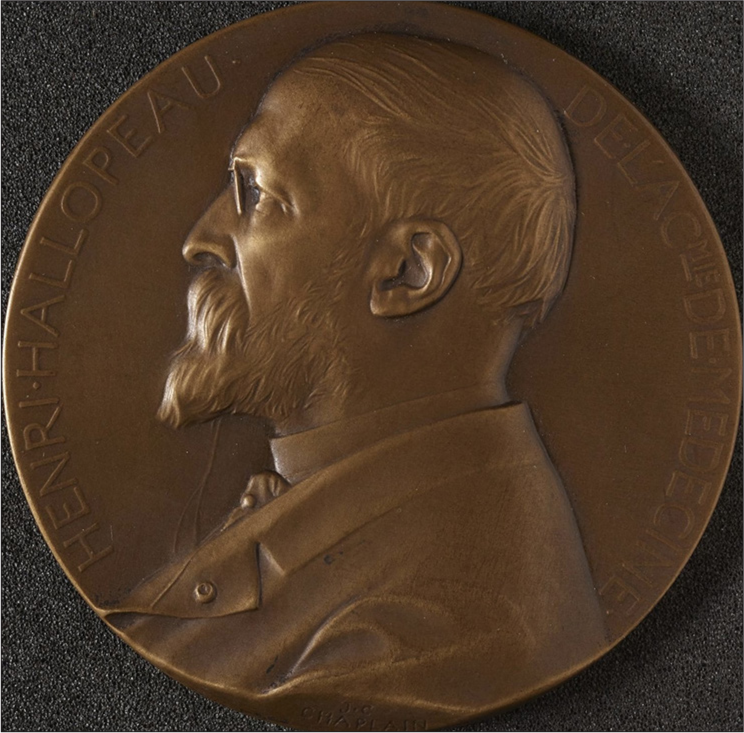Translate this page into:
A concise history of the contributions of Francois Henri Hallopeau (1842–1919): Serendipity in dermatology

*Corresponding author: Mohnish Sekar, Department of Dermatology, Karpaga Vinayaga Institute of Medical Sciences and Research Centre, Chennai, Tamil Nadu, India. mohnishsekar@gmail.com
-
Received: ,
Accepted: ,
How to cite this article: KavyaDeepu RM, Sekar M. A concise history of the contributions of Francois Henri Hallopeau (1842–1919): Serendipity in dermatology. CosmoDerma. 2025;5:25. doi: 10.25259/CSDM_225_2024
INTRODUCTION
Francois Henri Hallopeau was a magnificent figure in dermatology, exploring the interconnections between the brain, skin, and bodily fluids. He became immersed in cutaneous disorders, leading to the discovery of numerous entities and terminologies. Hallopeau has completed three dynamic and demanding specialties such as neurology, dermatology, and pathology. His achievements and influence on literary science will continue to resonate for generations. This historical review examines his life, interests, endeavors, and tenacity that underpinned his discoveries.
BIRTH AND LINEAGE
Francois Henri Hallopeau [Figure 1] was born on January 17, 1842, in Paris. His parents were Francois Hallopeau, a customs official, and Adelaide Rossignol.[1,2]

- Portrait of Francois Henri Hallopeau Image credit: Wikimedia Commons. This image is distributed under the terms of the Creative Commons Attribution-NonCommercial 4.0 International License.
PERSONALITY TRAITS
Hallopeau was noted for his benevolence and joviality, his gentle voice that lacked projection, and his renowned myopia, which rendered him a subject of ridicule among his peers and students.[2]
RESIDENCY AND AFFILIATED ACADEMIC ESTABLISHMENT
Francois Henri Hallopeau was a prominent member of the French dermatological school throughout the nineteenth century. He commenced his career as a student of the neurological system before moving to general pathology. He was only captivated by dermatology throughout his peak.[3] He enrolled in the Paris Medical School in 1858 after completing his secondary education at the esteemed Lycée Condorcet (previously Lycée Bonaparte) in 1857. After successfully passing the Paris Hospitals examination in 1863 as a non-resident student, he undertook several apprenticeships in the department of Alfred Louis Philippe Hardy (1811–1893) at Saint-Louis Hospital and Lariboisière Hospital under surgeon Gabriel Édouard Cusco (1819–1894). He secured second place in the arduous residency test on December 28, 1866. In addition, he was a resident under Nathan Oulmont (1815–1884), Sigismond Jaccoud (1830–1913), Auguste Millard (1830–1915), and lastly Vulpian. His dissertation, titled “Convulsive Seizures in Spinal Cord Diseases,” was defended on June 30, 1871. His subsequent thesis, “Mercury, Physiological and Therapeutic Action,” received approval in 1871.[2] The term “antibiotic” is credited to Hallopeau, who first employed it in 1871 to denote a chemical that disrupts vital energies [Table 1].[2]
| Period | Attainments |
|---|---|
| 1866 | Scored Second in Residency Test |
| 1871 | First to coin the term “Antibiotic” |
| 1887 | First to describe “Lichen sclerosus et atrophicus” |
| 1889 | First to coin the term “Trichotillomania” |
| 1890 | First to describe “Acrodermatitis continua of Hallopeau” |
| 1890 | Co-founded the French Society of Dermatology and Syphiligraphy |
| 1893 | General Secretary of French Dermatological Society |
| 1893 | Presented one of the first reports of Acanthosis Nigricans |
| 1907 | Commemorated with a round bronze medal. |
PRIVATE LIFE
In 1873, Hallopeau tied the knot with Alice Nicolas de Meissas. Their child, Paul Hallopeau (1876–1924), was a well-respected surgeon in Parisian hospitals.[2]
EXPEDITION AND INNOVATION IN DERMATOLOGY
Francois was affiliated with the Tenon and St. Antoine hospitals before commencing his tenure as a physician at Hospital Saint Louis in 1884, where he remained until his retirement in 1907. He commenced his work at Hospital Saint Louis as a neurologist before exclusively focusing on dermatology. Numerous descriptions of cutaneous problems established the groundwork for the first edition of his “Practical Treatise on Dermatology.”[4]
He evolved into a prominent dermatologist and syphilographer and was acknowledged for his contributions to four syndromes named after him, leading to his posthumous fame. These include pyoderma vegetans (PV) of Hallopeau, pemphigus vegetans of Hallopeau, acrodermatitis continua of Hallopeau (ACH), and a genetic disease, Hallopeau–-Siemens syndrome, which is a variant of dystrophic epidermolysis bullosa.[2]
The following is a compilation of his contributions to the discipline of dermatology:
ACH
In 1890, Francois Henri Hallopeau described a painful acral pustular condition marked by sterile pustules affecting the distal fingers and, less frequently, the toes. ACH, or dermatitis repens, is a rare and often debilitating illness predominantly affecting middle-aged women [Table 1]. Hyperemia affects the distal portion of one or two fingers, causing pustules to develop and spread proximally. Pustulation of the nail bed and matrix can result in onychodystrophy and anonychia. Chronic, recalcitrant, or untreated events cause cutaneous atrophy, dermal sclerosis, distal phalangeal osteolysis, and interphalangeal joint arthropathy.[5]
PV
PV is a rare chronic inflammatory disorder characterized by vegetating pustules and plaques affecting the skin and mucosal membranes. This entity is primarily associated with inflammatory bowel disease, chronic malnutrition, human immunodeficiency virus, malignancies, and other immunocompromised conditions. In 1898, Hallopeau published the first report of this entity [Table 1]. The scalp, face, axilla, and genitalia are the most common sites affected by this condition; the trunk and abdomen are less prevalent. Later, in 1949, McCarthy documented that certain patients exhibited oral mucosal lesions alongside pemphigus vegetans. Since then, “pyodermatitis-pyostomatitis vegetans” has been employed to denote these two disorders as a cohesive clinicopathologic entity.[6]
Pemphigus vegetans of Hallopeau
Pemphigus vegetans of Hallopeau is a localized variant of Pemphigus vulgaris, named after François Henri Hallopeau. It is primarily characterized by pustules, in contrast to the bullae and erosions observed in Pemphigus vegetans of Neumann. Both variants eventually develop into hyperpigmented vegetative plaques with pustules and hypertrophic granulation tissue along the periphery of the lesions.[7]
Hallopeau–Siemens syndrome
Recessive dystrophic epidermolysis bullosa, referred to as the Hallopeau–Siemens type of epidermolysis bullosa, was named after Francois Henri Hallopeau and German dermatologist Hermann Werner Siemens.[8] This condition is characterized by a genetic defect in collagen VII, leading to absent or insufficient anchoring fibrils. Clinically, it manifests as significant blistering following trivial trauma, which subsequently heals with scar formation. Complications include hypoalbuminemia, anemia, secondary infections, esophageal strictures, malignant transformation, hand anomalies presenting as flexion contractures, pseudosyndactyly, and mitten-like deformity.[9]
Epidermolysis bullosa simplex (EBS)
Hallopeau and Brocq proposed the terms Traumatic pemphigus, congenital traumatic blistering, and acantholysis bullosa for EBS in the late 19th and early 20th centuries; these terms are now obsolete.[10]
Trichotillomania
In 1889, Hallopeau was the first to coin “trichotillomania” after observing a young male patient who had extracted tufts of his hair [Table 1]. The term originates from the Greek words thrix (hair), tillein (to pull), and mania (madness).[4]
Lichen sclerosis et atrophicus
In a clinical lecture in 1887, Hallopeau was the first to describe lichen planus atrophique, currently referred to as lichen sclerosus et atrophicus [Table 1]. Since January 17, his birthday has been recognized as World Lichen Sclerosus Awareness Day.[4]
Tuberous sclerosis
In 1895, Hallopeau and Emille Leredde published histological findings on Adenoma sebaceum, demonstrating the aberrant proliferation of sclerotic dermal components alongside sebaceous glands. Furthermore, an association was noted between epilepsy and the facial lesions associated with tuberous sclerosis.[11,12]
OTHER NOTABLE WORKS
In 1890, he co-founded the French Society of Dermatology and Syphiligraphy and became its secretary general in 1893 [Table 1].[4]
His extensive communication on dermatological condition descriptions, which served as the basis for his Practical Treatise on Dermatology, includes syphilis, leprosy, tuberculosis, lupus vulgaris, lupus erythematosus, dermatitis herpetiformis, infantile vaccinia, dermatitis, eczema, and the erythematous stage of mycosis fungoides.
Hallopeau presented one of the first reports of acanthosis nigricans from the French school to the French Society of Dermatologists in 1893 [Table 1].[3]
Regarding mycosis fungoides, Hallopeau has authored no <26 publications.
He was the first to differentiate between eczema and premycosis erythema.
Hallopeau collaborated with his student Charles Fouquet to produce a detailed dissertation on syphilis.
During the arsenical and mercurial treatment era of syphilis, Hallopeau initially tried sodium arsenate and subsequently sodium acetyl arsanilate as a treatment modality of syphilis but discontinued both due to their tendency to induce optic neuritis. He subsequently argued that hectine was the superior arsenical treatment for syphilis and promoted its use.[13]
RETIRAL AND DEMISE
Upon retirement from Saint Louis Hospital in 1907 due to age limitations, he was commemorated with a round bronze medal [Table 1 and Figure 2].[2,14] In addition, he was a consulting physician at the Maison Départmentale of Nanterre until 1918, when declining vision and other health issues necessitated his complete retirement. Hallopeau passed away on March 19, 1919, at his residence in Paris, shortly after participating in the inaugural post-war session of the French Society of Dermatology.[2]

- Round bronze medal of Hallopeau. Image credit: J.C. Chaplain, French, 1907.Science Museum Group. This image is distributed under the terms of the Creative Commons Attribution-NonCommercial 4.0 International License.
CONCLUSION
Neurologist by chance, yet dermatologist by choice. Francois Henri Hallopeau is an indomitable character whose legacy in dermatology persists, with his influence on skin science remaining significant. His descriptions in a collection of over 800 papers contribute to his enduring prominence.
Ethical approval
Institutional Review Board approval is not required.
Declaration of patient consent
Patient’s consent is not required, as there are no patients in this study.
Conflicts of interest
There are no conflicts of interest.
Use of artificial intelligence (AI)-assisted technology for manuscript preparation
The authors confirm that there was no use of artificial intelligence (AI)-assisted technology for assisting in the writing or editing of the manuscript and no images were manipulated using AI.
Financial support and sponsorship: Nil.
References
- François Henri Hallopeau. 2012. Wikimedia commons. Available from: https://commons.wikimedia.org/wiki/file:françois_henri_hallopeau.jpg#filehistory [Last accessed on 2024 Dec 23]
- [Google Scholar]
- The neurologist Henri Hallopeau (1842-1919), a famous dermatologist. Rev Neurol (Paris). 2025;181:124-30.
- [CrossRef] [PubMed] [Google Scholar]
- H14 francois Henri Hallopeau: Pulling out the hair and picking out the spots. Br J Dermatol. 2024;191:i171.
- [CrossRef] [Google Scholar]
- Autoinflammatory pustular neutrophilic diseases. Dermatol Clin. 2013;31:405-25.
- [CrossRef] [PubMed] [Google Scholar]
- Pyoderma vegetans: A case report in a child suspected to primary immunodeficiency and review of the literature. Iran J Med Sci. 2015;40:381-5.
- [Google Scholar]
- The neumann type of pemphigus vegetans treated with combination of dapsone and steroid. Ann Dermatol. 2011;23(Suppl 3):S310-3.
- [CrossRef] [PubMed] [Google Scholar]
- A mini-review on eponyms in the dermatology literature linked to France. Our Dermatol Online. 2013;4:440-3.
- [CrossRef] [Google Scholar]
- Epidermolysis bullosa dystrophica (Hallopeau-siemens) an der hand--operative strategie und ergebnisse [Epidermolysis bullosa dystrophica (Hallopeau-siemens syndrome) of the hand--surgical strategy and results] Handchir Mikrochir Plast Chir. 2005;37:316-22.
- [CrossRef] [PubMed] [Google Scholar]
- Epidermolysis bullosa: Clinical, epidemiologic, and laboratory advances and the findings of the national epidermolysis bullosa registry (1st ed). Baltimore: Johns Hopkins University Press; 1999.
- [Google Scholar]
- The early history of tuberous sclerosis. Arch Dermatol. 1979;115:1317-9.
- [CrossRef] [Google Scholar]
- Bronze medal commemorates F.H Hallopeau. 2024. Science Museum Group. Available from: https://collection.sciencemuseumgroup.org.uk/objects/co69485/bronze-medal [Last accessed on 2024 Dec 23]
- [Google Scholar]






